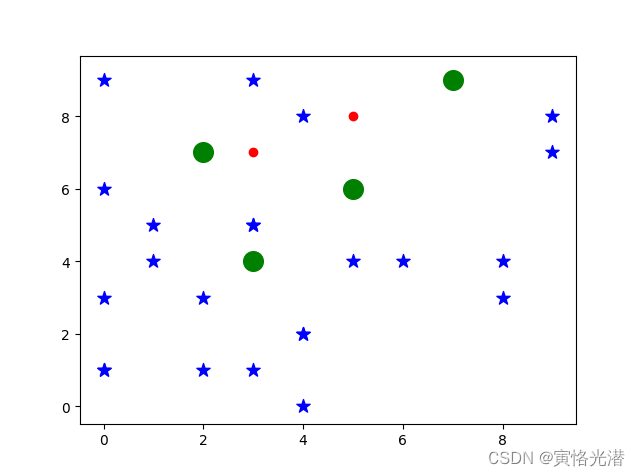散点图的应用很广泛,以前介绍过很多画图方法:Python画图(直方图、多张子图、二维图形、三维图形以及图中图),漏掉了这个,现在补上,用法很简单,我们可以help(plt.scatter)看下它的用法:
Help on function scatter in module matplotlib.pyplot:
scatter(x, y, s=None, c=None, marker=None, cmap=None, norm=None, vmin=None,
vmax=None, alpha=None, linewidths=None, verts=None, edgecolors=None, hold=None, data=None, **kwargs)
Make a scatter plot of `x` vs `y`
Marker size is scaled by `s` and marker color is mapped to `c`
Parameters
----------
x, y : array_like, shape (n, )
Input data
s : scalar or array_like, shape (n, ), optional
size in points^2. Default is `rcParams['lines.markersize'] ** 2`.
c : color, sequence, or sequence of color, optional, default: 'b'
`c` can be a single color format string, or a sequence of color
specifications of length `N`, or a sequence of `N` numbers to be
mapped to colors using the `cmap` and `norm` specified via kwargs
(see below). Note that `c` should not be a single numeric RGB or
RGBA sequence because that is indistinguishable from an array of
values to be colormapped. `c` can be a 2-D array in which the
rows are RGB or RGBA, however, including the case of a single
row to specify the same color for all points.
marker : `~matplotlib.markers.MarkerStyle`, optional, default: 'o'
See `~matplotlib.markers` for more information on the different
styles of markers scatter supports. `marker` can be either
an instance of the class or the text shorthand for a particular
marker.
cmap : `~matplotlib.colors.Colormap`, optional, default: None
A `~matplotlib.colors.Colormap` instance or registered name.
`cmap` is only used if `c` is an array of floats. If None,
defaults to rc `image.cmap`.
norm : `~matplotlib.colors.Normalize`, optional, default: None
A `~matplotlib.colors.Normalize` instance is used to scale
luminance data to 0, 1. `norm` is only used if `c` is an array of
floats. If `None`, use the default :func:`normalize`.
vmin, vmax : scalar, optional, default: None
`vmin` and `vmax` are used in conjunction with `norm` to normalize
luminance data. If either are `None`, the min and max of the
color array is used. Note if you pass a `norm` instance, your
settings for `vmin` and `vmax` will be ignored.
alpha : scalar, optional, default: None
The alpha blending value, between 0 (transparent) and 1 (opaque)
linewidths : scalar or array_like, optional, default: None
If None, defaults to (lines.linewidth,).
verts : sequence of (x, y), optional
If `marker` is None, these vertices will be used to
construct the marker. The center of the marker is located
at (0,0) in normalized units. The overall marker is rescaled
by ``s``.
edgecolors : color or sequence of color, optional, default: None
If None, defaults to 'face'
If 'face', the edge color will always be the same as
the face color.
If it is 'none', the patch boundary will not
be drawn.
For non-filled markers, the `edgecolors` kwarg
is ignored and forced to 'face' internally.
Returns
-------
paths : `~matplotlib.collections.PathCollection`
Other parameters
----------------
kwargs : `~matplotlib.collections.Collection` properties
See Also
--------
plot : to plot scatter plots when markers are identical in size and
color
Notes
-----
* The `plot` function will be faster for scatterplots where markers
don't vary in size or color.
* Any or all of `x`, `y`, `s`, and `c` may be masked arrays, in which
case all masks will be combined and only unmasked points will be
plotted.
Fundamentally, scatter works with 1-D arrays; `x`, `y`, `s`, and `c`
may be input as 2-D arrays, but within scatter they will be
flattened. The exception is `c`, which will be flattened only if its
size matches the size of `x` and `y`.
我们可以看到参数比较多,平时主要用到的就是大小、颜色、样式这三个参数
s:形状的大小,默认 20,也可以是个数组,数组每个参数为对应点的大小,数值越大对应的图中的点越大。
c:形状的颜色,"b":blue "g":green "r":red "c":cyan(蓝绿色,青色) "m":magenta(洋红色,品红色) "y":yellow "k":black "w":white
marker:常见的形状有如下
".":点 ",":像素点 "o":圆形
"v":朝下三角形 "^":朝上三角形 "<":朝左三角形 ">":朝右三角形
"s":正方形 "p":五边星 "*":星型
"h":1号六角形 "H":2号六角形"+":+号标记 "x":x号标记
"D":菱形 "d":小型菱形
"|":垂直线形 "_":水平线形
我们来看几个示例(在一张图显示了)
import matplotlib.pyplot as plt
import numpy as np
import pandas as pd
x=np.array([3,5])
y=np.array([7,8])
x1=np.random.randint(10,size=(25,))
y1=np.random.randint(10,size=(25,))
plt.scatter(x,y,c='r')
plt.scatter(x1,y1,s=100,c='b',marker='*')
#使用pandas来读取
x2=[]
y2=[]
rdata=pd.read_table('1.txt',header=None)
for i in range(len(rdata[0])):
x2.append(rdata[0][i].split(',')[0])
y2.append(rdata[0][i].split(',')[1])
plt.scatter(x2,y2,s=200,c='g',marker='o')
plt.show()
其中文档1.txt内容如下(上面图中的4个绿色大点)
5,6
7,9
3,4
2,7
文章出处登录后可见!
已经登录?立即刷新
